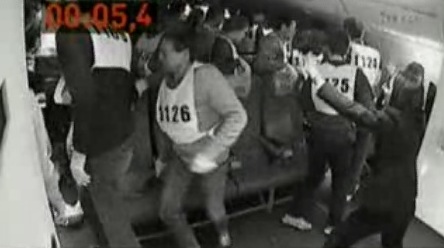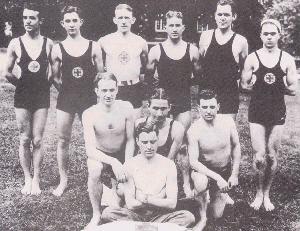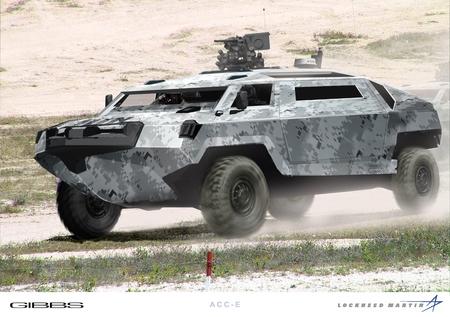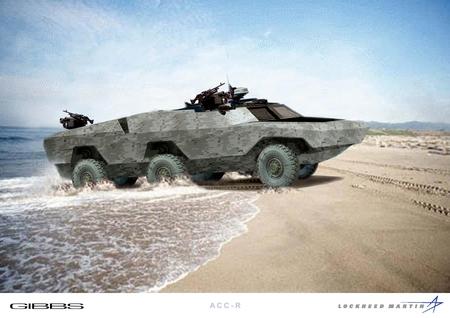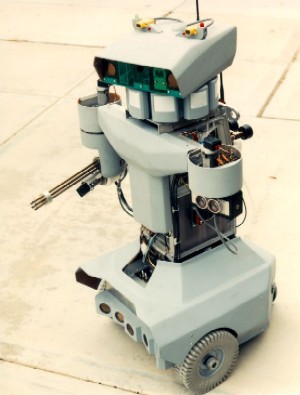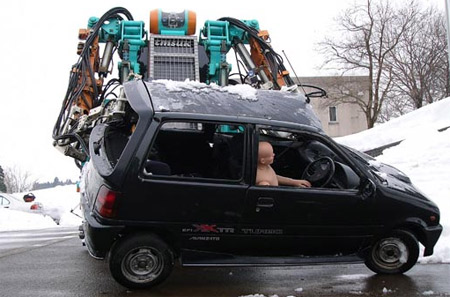In January, BLDG Blog (“Building Blog”) reported on Matthew C. Wright’s Washington Post coverage of the situation in Picher, Oklahoma. Picher had lead and zinc mines operated until the 1970’s, and it’s been on the Superfund List – part of the Tar Creek SuperFund Site.
Category Archives: Uncategorized
Ask Umbra: a new source for advice about solar
has a new feature – “Ask Umbra” – in Q&A format giving advice about how to get solar working. From today’s post – in which a reader from Long Island, New York. Here’s Umbra’s response to “Rick”:
Don’t thank me until you’ve tried my recommendations in the marketplace.
Solar power to the people. Photo credit: iStockphoto
Your county’s rating for solar is “good,” according to Findsolar.com, a private/public collaborative website that has various worksheets helping you figure out what solar can do in your area, what size array you might need, how much it will cost, etc.
Government working up plan to prevent chaos in wake of bombing of major city
The San Francisco Chronicle has reported, in a piece by James Sterngold, Â that
a high-level group of government and military officials has been quietly preparing an emergency survival program that would include the building of bomb shelters, steps to prevent panicked evacuations and the possible suspension of some civil liberties.
Airbus test evacuation inspires great confidence.
And at least a little sarcasm. Check out this post from Telstar Logistics, describing a recent test of Airbus evacuation employees. This test was done with Lufthansa employees, without smoke, fire, or other conditions which – assuming an emergency evacuation in the first place, would seem to be within the real of possibility.
How long would it take for everyone to get off the A-380?
In a best-case scenario, with no smoke, no fire, limited structural damage to the aircraft, and no one who sustained any injuries during the landing, it would take a little under 80 seconds to evacuate 853 passengers and 20 crew members from an A380.
…. even under those most ideal of circumstances, there were casualties: one broken leg and 32 friction burns.
It’s clear that the thing to do is just make sure that bad things only happen during ideal conditions.  There’s also a link to a YouTube clip of the evacuation exercise – and an even more disturbing bit from the Wall Street Journal about a McDonnell Douglas evacuation exercise.
Derivative tip of the hat to Upgrade: Travel Better. Direct tip of aforementioned chapeau to Telstar Logistics. Link to Telstar post here.
First U.S. Volunteer rescue squad founded – 1928
We’re given to understand that Stanley Wise (1900 – 1985), nine years old, saw two men capsize a canoe in the Roanoke River. Many people were present and watched the accident – but none had the toolsor expertise to attempt a rescue. Both men died.
In 1928, with nine colleagues from the Norfolk & Western Railway, Wise started a rescue squad – with communications support from the city of Roanoke; a local funeral home provided an ambulance.
The wikipedia reference links to Ronanoke’s Volunteer Rescue Muesum
and to Pat Ivey’s EMT Rescue which title is new to us (ISBN-0-7592-4464-2), but we’re going to see if we can track down a copy.
AP Post on Levinson disappearance
Including a report that a petition, signed by 200 former FBI agents, has been given to the United States government, and quoting Levinson’s wife Christine, as follows:
“My husband, Bob Levinson, is still missing. We, his family, have not heard from him since March 8, and the silence is unbearable,” she said.
“Right now, we are living a nightmare. We need Bob to come home to us. We are aware of all the rumors out there which have raised our hopes, only to have them crushed by the reality that we still have no information. We are asking anyone who has any information of any kind to please let us know.”
A petition signed by 200 former agents, we guess, is one neither widely circulated nor circulated for long. The Levinson League, to coin a phrase, is both wide and deep.
Debka claims Levinson released 1 May
In a piece dated 6 May, Debka File  reports that Bob Levinson was releasedon 1 May, and that the Iranians are miffed that some or all of the five Iranians held by the United States in Iraq.
Since we’re empiricists here at Popular Logistics, and our chief medical advisor is from a state adjacent to Missouri (the “show-me” state), we would like to believe the Debka report, but want firmer evidence.
Since Levinson owes at least one dinner to a senior editor of this blog, we’d accept Levinson’s presence at a meal in Brooklyn as sufficient evidence.
Stuart Brand: Lessons of the 1989 San Francisco Earthquake
 We think that Stuart Brand’s account of the 1989 SF earthquake is – if anything is – a “must-read” for anyone concerned with emergency preparedness. WorldChanging has done us all the service of reprinting it here.Â
From Brand’s piece:
Volunteer rescuers in San FranciscoÂ’s Marina District on the night of the 1989 earthquake outnumbered professionals three-to-one during the critical first few hours. And it still wasnÂ’’t enough. Only a small portion of the people present offered emergency help, despite the romanticized press to the contrary.
Considering the amount of money and bureaucracy spent (well spent) on preparing the Bay Area’s buildings for earthquakes, it is startling to realize how little is spent on preparing people. The widespread earthquake literature focuses on self-preservation, not on helping others, nor on the niceties of being helped. As a result, volunteer rescuers on October 17 had to make it up as they went—wasting vital time and making unnecessary mistakes.
My conclusions from Brand’s piece:
- Â Preparation and organization of citizen groups can pay off – providing critical surge capacity
- investing in communications systems acts as a force multiplier – allowing, among other things, for the rapid reallocation of resources
- Â In addition to the need for widespread advanced first-aid training and equipment – we need lots of people with construction and engineering skills – not only for the “emergency” – but also if we intend to rebuild.
Thanks to Gregory Cohen
of NGO Consulting for giving us the Stuart Brand piece.
Here’s a thought for a presidential campaign plank – from either party:
- A commitment to a citizen reserve corps
- decommissioned military and law enforcement communications equipment given to citizen groups -especially the non-encrypted systems, which government agencies now think obsolete
- Lots of free training in first aid, search-and-rescue, and construction techniques.
None of this is expensive; we’ll try to do the number later. We think it costs – done well – less than a month in Iraq.
President Bush emulates Mark Twain
Kris Alexander of the grossly misnamed Alexander the Average  had, some months ago, proposed a Civilian Reserve Corps.
Link to his PowerPoint presentation here.Â
We’re not sure how much this would vary from the original national CERT concept – in which (1) CERT teams would be encouraged to have advanced training, and (2) teams in non-affected areas would be transported to assist in affected areas.
Apparently, the President likes this idea – so much that he proposed it in his State of the Union address. Which – we must admit – we missed. Alexander suspects, in a piece entitled “The President Stole My Idea”), what Mark Twain called “unconscious appropriation.”
Nothing is ours but our language, our phrasing. If a man takes that from me (knowingly, purposely) he is a thief. If he takes it unconsciously–snaking it out of some old secluded corner of his memory, and mistaking it for a new birth instead of a mummy — he is no thief, and no man has a case against him.
Unconscious appropriation is utterly common; it is not plagiarism and is no crime; but conscious appropriation, i. e., plagiarism, is as rare as parricide. Of course there are plagiarists in the world–I am not disputing that–but bless you, they are few and far between. These notions of mine are not guesses; they are the outcome of twenty years of thought and observation upon this subject.
– Mark Twain (Samuel Clemens), Letter to Robert Burdette, circa 4/19/1890. Link here.
Our question – and forgive us – we haven’t finished the first cup of coffee yet – is – what’s happening with this fine idea?
In the meantime – Popular Logistics takes this opportunity to, once again, encourage those just beginning to think of these issues to do the following:
If you’ve concluded you need to act, go to Three Steps.
If you still need a little bit of persuasion, read Irwin Redlener’s book (cover in our left sidebar, if the CSS code is still working), and Stuart Brand’s account of the aftermath of the 1989 San Francisco earthquake. Link here.Â
visual representation of CIA rendition flights
Visual representation of CIA rendition flights.
 Direct link to chart here. Chart created by Trevor Paglan and John Emerson.
Via Visual Complexity .
What the NYPD and NYFD might be thinking of in a flood
If and when they find out that some of the planned “flood reception centers” are surrounded by non-functioning storm drains. Mere speculation on our part, of course.
Original post at Hemmings Blog here.
These and other models are manufactured by Gibbs Amphibian -Â either part of, or a collaboration with, Lockheed Martin.
For our household – we’re thinking pontoon boats.
Robot Rules of War
DefenseTech reports on a proposed set of robot rules of war.
Brooklynites: is your street a bit flooded? Please tell us
Neighbors – please help – we’re trying to collect data on storm drain performance in Brooklyn today during the flood alert.
Look for the tab marked “Submit Stormdrain Info” at the top of the page – it’ll take you to a simple form – tell us when and where – we’ll try to get it into a map later.
We hope, by the next time we have the opportunity to gather this or other similar data, to have a usable Google Maps (or other) GIS interface available. Please bear with us as we travel upwards on the learning curve.
JS
Rescue Robots
T/ A new type of life-saving robot: PRE-HOSPITAL CARE ROBOT
This new prototype robot was developed specifically for the AICHI EXPO 2005 in collaboration with Kyushu University.
Visitors to the EXPO who felt ill, were able to utilize this robot to get medical assistance at the theme parks and public facilities that were hard to get to by ambulance. This experimental robot immediately relays information to hospitals and first-aid rooms as soon as someone sits it. Then it, automatically, takes readings of the vital signs like, taking the pulse, measuring blood pressure, heart beat rate and blood oxygen.In emergencies, doctors can administer first- aid by giving instructions directly to the robot or through a speaker and microphone system to bystanders.
We don’t have a decent photo of the pre-hospital care robot – but we do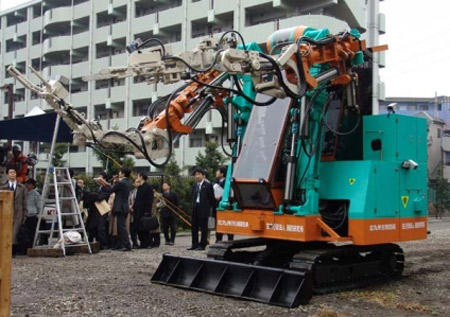
have two of the T-52 Enryu Rescue Robot.
Our understanding of the state of robotics in use in the United States for emergency work is that they’re largely limited to EOD (explosive ordinance and demolition) work – as applied in the domestic context, evaluating, transporting, and disarming suspected explosive devices.
Via Toolmonger. Whom (who?) we thank not only for pointing this out to us, but for their superior journalism (superior to me , in any case) by being willing to point out that, function aside, these robots are, in their words, “just cool.” Which they are.
The non-pictured pre-hospital care robot transmits diagnostic data ahead to the hospital. Â
Here’s the limitation of this equipment: in the context of large, horrible, hard-to-solve incidents, they’ll save lives. And save the lives of first responders. But in mass incidents – and when circumstances make them hard to transport – their function is less limited.
I’m as prone to fall in love with shiny new technology as the next person. Or more so. But the policy question might be – given a choice between one million-dollar robot – or ten forward-cached containers of medical supplies – which would be the better first use of financial resources?
Redlener’s Eight Principles – #1
without hesitation – especially for people who want an excellent overview. Calm, intelligent, well-reasoned – and well-written. We wish we’d written it – Popular Logistics was envisioned for people who’d gotten as far along as Dr. Redlener will take you – the details of the logistics that support robust community preparedness.
We’re going to give you each of Redlener’s Eight Principles – and try to add some useful detail.
#1. Stay Healthy and Fit.Â
S.L.A. Marshall – in his seminal essay The Soldier’s Load (a primary inspiration for this blog), makes two principal arguments:
- fear makes us tire more easily;
- physical fitness makes us more resistant to fear
In other words, fear and physical exhaustion on the one hand, and physical conditioning and preparedness on the other, are antagonists, Be prepared mentally and physically – you’ll not only be able to help yourself, you’ll be in a position to help others – and need less help for others.
But – where to start? What particular goals should we be training for, and how to go about it?
Here are physical standards for firefighters
- In London
- Excerpts from the United States Wildfire Firefighter job description:
- Participates in fire suppression activities in rugged mountainous terrain from sea level to over 10,000 ft. elevation. Uses a variety of hand tools, power saws, and pumps. Exposed to long and irregular working hours under exhausting conditions, including adverse weather conditions required to maintain physical performance over long periods of time.
- FUNCTIONAL REQUIREMENTS
- Â Heavy lifting, 45 pounds and over
- Â Heavy carrying, 45 pounds and over
- Pulling hand over hand (8 hours)
- Reaching above shoulder
- Walking (16 hours)
- Standing (16 hours)
- Kneeling (3 hours)
- Repeat bending (12 hours)
- Climbing, legs only (8 hours)
- Climbing, use of legs and arms
- Ability for rapid mental and muscular execution simultaneously(emphasis added)
The International Association of Firefighters/IChief “Candidate Physical Assessment Test (excerpt)
- Participates in fire suppression activities in rugged mountainous terrain from sea level to over 10,000 ft. elevation. Uses a variety of hand tools, power saws, and pumps. Exposed to long and irregular working hours under exhausting conditions, including adverse weather conditions required to maintain physical performance over long periods of time.
During the entire test the candidate must wear a 50 lb. weighted vest (simulating the weight of a fire fighters protective clothing and equipment). The eight events are:
-
- Stair Climb (climbing stairs while carrying an additional 25 lb. simulated hose pack),
- Ladder Raise and Extension (placing a ground ladder at the fire scene and extending the ladder to the roof or a window),
- Hose Drag (stretching uncharged hoselines, advancing lines),
- Equipment Carry (removing and carrying equipment from fire apparatus to fireground),
- Forcible Entry (penetrating a locked door, breaching a wall) and
- Search (crawling through dark unpredictable areas to search for victims).
- Rescue Drag (removing victim or partner from a fire building),
- Ceiling Pull (locating fire and checking for fire extension)
We’ll be coming back to this. In our neck of the woods – Brooklyn – we’re trying to construct a confidence course (obstacle course) that will be fun – and also help us build cooperative skills, increase fitness – and that will be fun enough that it’ll be an aid to recruitment.
Stay tuned for more from Dr. Redlener – his excellent advice – and we’ll provide as many recipes as we can.


